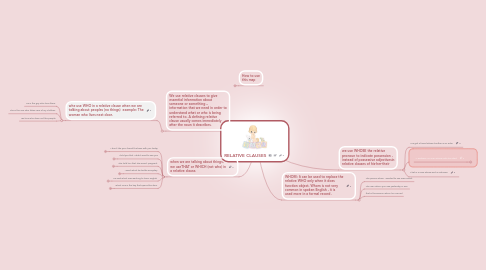
1. How to use this map
1.1. Use this map to prepare for your first baby
1.2. Pregnancy
1.2.1. We've already prepared lists of recommendable foods and those you should avoid during your pregnancy
1.2.2. The check-up schedule is a list of generally recommended check-ups you should attend during your pregnancy. Add the dates of your actual appointments using "Tasks" and check them off once you've completed them
1.2.3. Follow the links provided for the different topics to get ideas for exercise routines and to find out what awaits you at childbirth class.
1.2.3.1. Add your own schedules using the "Task" option
1.3. Hospital
1.3.1. Make a list of all essential items you want to take with you when the big day comes
1.3.2. Check out the link to get ideas and find out what you really need
1.4. Immunization schedule
1.4.1. We've prepared a list of generally recommended immunizations and when they are due. Follow the link or ask your doctor or midwife to get more information
1.4.2. Add the dates of your actual appointments using the "Task" function
1.5. Checklist
1.5.1. Write down all the items you need to acquire before your baby arrives
1.5.2. Check out the link to find out what's essential
2. We use relative clauses to give essential information about someone or something – information that we need in order to understand what or who is being referred to. A defining relative clause usually comes immediately after the noun it describes.
2.1. whe use WHO in a relative clause when we are talking about peoples (no things) example: The woman who lives next door.
2.1.1. He is the guy who lives there
2.1.2. she is the one who takes care of my children
2.1.3. Yes he's who does not like people
3. when we are talking about things, we useTHAT or WHICH (not who) in a relative clause.
3.1. I don’t like your friend that was with you today
3.1.1. Hepatitis B vaccine (HBV)
3.2. I told you that I didn't want to see you
3.2.1. Second dose HBV
3.3. She told him that she wasn't pregnant
3.3.1. DTaP: Diphtheria, tetanus, and acellular pertussis vaccine
3.3.2. Hib: Haemophilus influenzae type b vaccine
3.3.3. IPV: Inactivated poliovirus vaccine
3.3.4. PCV: Pneumococcal conjugate vaccine
3.3.5. Rota: Rotavirus vaccine
3.4. I want which be better everyday
3.4.1. DTaP
3.4.2. Hib
3.4.3. IPV
3.4.4. PCV
3.4.5. Rota
3.5. He said which was wanting to learn english
3.5.1. DTaP
3.5.2. Hib
3.5.3. PCV
3.5.4. Rota
3.6. which one is the key that opens this door
3.6.1. Influenza
4. we use WHOSE the relative pronoun to indicate possession , instead of possessive adjectivesin relative clauses of his-her-their
4.1. I’ve got a friend whose brother is an actor
4.2. A widower is a man whose wife has died
4.2.1. 8-12 weeks: Initial prenatal visit
4.2.2. Optional genetic counseling visit
4.2.3. First two trimesters: Prenatal visits continue every 4-6 weeks
4.2.4. 15 to 20 weeks: Quad Screen test
4.2.5. 27 or 28 weeks: Glucose challenge test
4.2.6. 28 to 36 weeks: After 28 weeks, prenatal visits continue every 2-3 weeks until 36 weeks.
4.2.7. 36 weeks: Pelvic exam and Group B Strep test
4.2.8. 36 to 40 weeks
4.2.9. 40+ weeks
